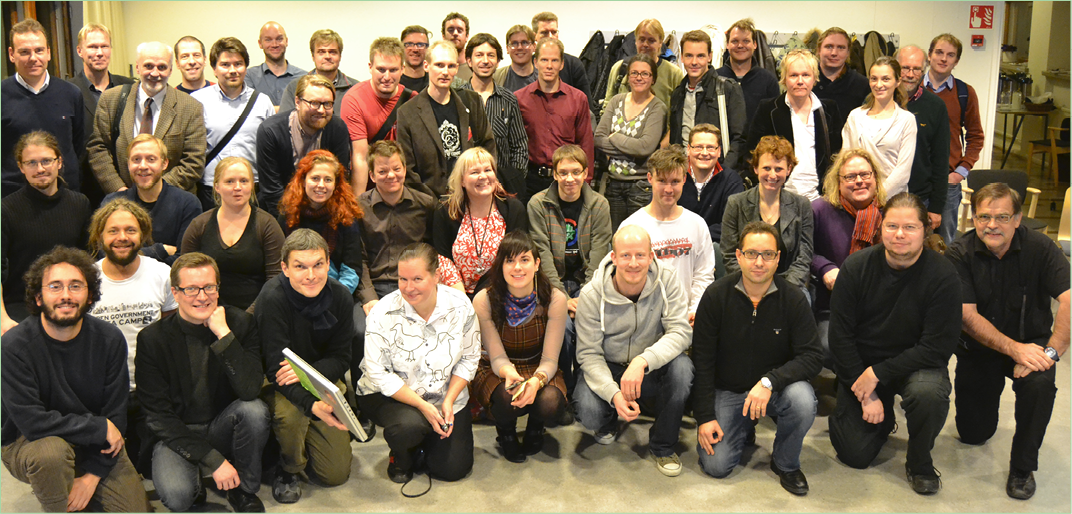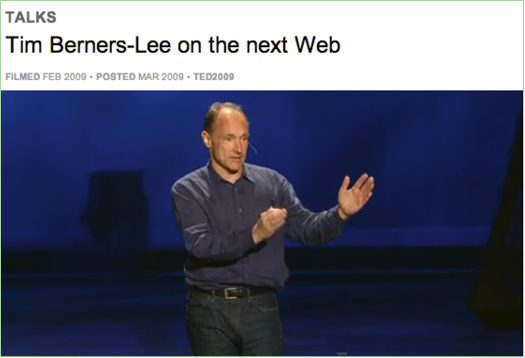Text Petja Partanen Valokuva Hannu Mäkäräinen, CC BY-SA 2.0-lisenssi
In the course of just four years, the open data movement has progressed from idealism to practice.
September 2012. An auditorium full to the brim is giving standing applause – to a university professor. The star speaker on the stage is the data visualiser Hans Rosling. His one hour long lecture at the Open Knowledge Festival in Helsinki has convinced the audience that open data is the “thing”. At least for those who seek to understand how the world works.
The Swedish professor Rosling uses numerical data to show that many of the ideas we have about the world simply do not hold true. With data visualisation tools and raw statistical data, this mythbuster demonstrates a breathtaking amount of evidence about the ways in which the world really works. He also finds some time to praise the success of the Finnish school system and the constitution of United States.
“It is a rather good constitution considering the openness of information. Data belongs to the people.”
Cue back to 1989. The concept of open data did not yet exist. Tim Berners-Lee, then a researcher at CERN and the future inventor of the World Wide Web, wrote for the first time a web address beginning with the letters ‘http’. Meanwhile in Finland, Antti Rainio at the National Land Survey wrote an article about the pricing of data in the journal Maankäyttö. Digital geodata should be cheap if not free, he argued. ”If the data has been produced, we have to ensure all the possible benefits for the economy by using it.”
Today, everyone is talking about open knowledge, the Web will soon celebrate its 25th anniversary, and Antti Rainio’s wish has come true. If you log in to the National Land Survey’s open data download service and type in, say, your summer house’s address, the basic map and aerial photo of the area will soon appear in the shopping basket. Click on ‘Order’ and a 60-megabyte data file is downloaded
onto your hard disk, free of charge. The resolution of the amazingly accurate aerial photo is around half metre. You can make out the shape of the caravan that stood on the yard two years ago when the photo was taken.
An office tower in Helsinki’s Pasila district holds the headquarters of the National Land Survey. Senior Advisor Antti Rainio is a content man these days. The National Land Survey opened its data resources to the public on 1 May 2012 as the first Finnish government office, and Rainio was voted as the most influential IT person of the year for his merits in opening public data resources.
Defying Google
For many years, Rainio and his colleagues watched helplessly as the free but rough-quality Google maps were used in different online map services instead of the National Land Survey’s top class digital map resources. Now it finally seems the tables have turned. Since the government agency stopped charging users for their service, the use of digital geodata has increased over 50 times. ‘Mr Open Data Finland’ is optimistic about the future.
“The development will lead to a situation where all the major public data resources are accessible and used by all”, says Rainio. “This will enable better decision-making, better civic services as well as better commercial applications”, says Rainio.
Opening geodata free of cost for public use required some changes to the legislation. These changes met resistance from the keepers of the public coffers, since the fees paid by the data users provided revenues for the agency. The fate of the legislation change was perhaps decided by an EU Commission communication which estimated that opening public data could bring a total benefit of € 140 billion annually. According to a research by the Research Institute of the Finnish Economy ETLA, in countries which offer free geodata, the growth of companies using such data has been 15% higher than elsewhere.
”The fact that the USA is the world’s leading provider of geodata software is because the ‘fuel’ – map data – has been freely available”, says Antti Rainio.
The idea of opening public data has arrived to Finland from the United States and the UK. The breakthrough was made in 2009 when the US government’s open data catalogue data.gov was opened. The UK government’s data.gov.uk followed shortly afterwards. Among cities, Washington was the forerunner, and it had the idea of speeding up the use of open data by arranging a competition for applications. Inspired by that example, Finland’s Apps for Democracy contest, later renamed Apps4Finland, saw the light of day in autumn 2009.
Try-and-learn culture in the municipal sector
Officials are often blamed for being slow to adopt new ideas, but when it comes to open knowledge, the region of Helsinki has been very much attuned to the times.
The Helsinki Region Infoshare project was launched on a rapid schedule. The working method was also new. Petri Kola, chairman of Open Knowledge Foundation Finland, talks about a “try-and-learn” culture. Kola has himself previously worked for the HRI project. ”In public administration, you rarely see anything resembling the HRI project: we simply started trying different things and learned along the way.”
One of the experiments was whether Helsinki’s case management system Ahjo, a paperless office for 5,000 city officials and decision-makers, could be opened to the public. The Helsinki Region Infoshare team set off to work by arranging a meeting between officials from the city’s Administration Centre and application developers, so the two groups could work together on the subject. In one year, the project progressed from a good idea into an open data interface.
The HRI team also travels around to meet officials of other cities and various departments, in search of data that could be published. They give guidance to the officials in making the data openly available online, and the data reserves are added to the Hri.fi data catalogue. Latest datasets are then advertised to the application developers.
The feedback from the users of the data is crucially important when discussing the possible benefits of opening knowledge. It is difficult to estimate in advance what kind of data the coders would find useful as the basis for new applications.
Many of those who have opened their data have been pleasantly surprised to see the data reserves end up in good use. One example is the public transport utility of the Helsinki Region, HRT. The online schedule service of Helsinki Region Transport, reittiopas.fi, is one of the most popular web services in Finland. Data on public transport routes and schedules has been publicly available since 2009. The cost of publishing them as open data was rather modest. The open data interface and its maintenance has cost 60 000 euro in three years, that is roughly one per cent of the total costs of the whole data system.
HRT drummed up some publicity for the interface with its Mobiilikisa (“Mobile Challenge”) competition. The application challenge produced more than 60 mobile applications making use of the interface services. Today, many people use their mobile phone to find their way to the right bus.
“It is hard to imagine how we could have achieved such a wide offering of mobile services with the resources we had. Had we started to develop the mobile applications by ourselves, it could have easily cost 50,000 euro apiece”, HRT project manager Jari Honkonen estimates.
Activists convene online
The discussion threads in the Finnish Open Data Ecosystem Facebook group have grown in length. More than a thousand members mull over the various aspects of open knowledge from many perspectives – from the EU’s public sector information directive to open source programming tools.
When Antti Poikola, one of the pioneers of the Finnish open data movement, challenged the group members to think back about the early days, many mentioned the award ceremony of the Apps For Democracy contest in Tampere in 2009 as the moment that inspired them to become involved in open data. People interested in open data met there for the first time and the community started to grow. It was the enthusiasm of the pioneers, rather than official decisions, which spread the “gospel” of open data at the first stage. The award ceremony of 2011 Apps4Finland competition was already a major event. Corporate IT directors and public-sector officials were present at the occasion. Open knowledge had suddenly become fashionable.
Browsing through the Open Data Ecosystem member list these days, one finds that many journalists and entrepreneurs – as well as a bunch of officials interested in data reserves – have joined the ranks alongside the academic “hard core”. One enthusiast from the official sector is Inspector General of the Finnish Tax Administration Johanna Kotipelto.
Johanna Kotipelto was in charge of licensing the first open data set published by the tax administration and adding that data to the public data catalogues. Now anyone can download the complete corporate tax data of Finland as one CSV file and see how much tax each corporation or association has paid in the previous year. This makes the job of journalists easier. When the newspaper Helsingin Sanomat, for instance, in September 2012 reported that major businesses pay only 5 per cent of profits in taxes, the reporter had to go to the tax office’s public terminals to look for the data on corporate taxes. Today, reporting that news would be much easier. Today, reporting that news would be much easier.
Open data is an asset for Finland
It seems certain that public administration has joined the open data movement for good. The objective to open up public data resources for all to use has been recorded in two successive government programmes. The state administration has just launched its own Open Knowledge Programme, which includes building a nationwide open data catalogue. Petri Kola hopes that the municipalities and the state administration will remember that the opening of data will only start bringing benefits when the data is put into use.
”It is worthwhile to seek contacts with the potential users of the data sets”. By listening to third party users your own organization may also learn a lot. ”At first it is useful to publish something simple, preferably data on map, which helps to understand the municipality spatially. The locations of municipal offices and service points, administrative districts, building sites, traffic accidents, noise pollution observations…”.
Why is this important then? Let us ask a philosopher. “It is beneficial for Finland; a competitive asset”, says Ilkka Niiniluoto, Chancellor of the University of Helsinki. “Open data helps society function better and enables the search for new solutions.”
Tweet
- •
The texts of the publication are licensed under the 'HRI-nimeä' attribution. All reuse of the material must be accompanied by the name of the author (Petja Partanen or Terhi Upola) and the publisher (Helsinki Region Infoshare).

The world’s largest open knowledge event gathered around 1,000 enthusiasts of open data and open governance to Helsinki in September 2012.
Inventor of the World Wide Web, advocate of open data
Tim Berners-Lee explained in a famous TED talk in February 2009 why opening data is the next giant step in the development of the World Wide Web. ”Put your data on the web in a machine readable form.” http://bit.ly/v2L9bC

Present at the first assembly of the association in November 2011 were the ‘hard core’ of Finland’s open knowledge activists.
Open Knowledge Foundation Finland
Founded in December 2012, the association
Open Knowledge Foundation Finland gathers together the Finnish enthusiasts and experts of open data. OKF Finland is part of the world’s largest open data community, Open Knowledge Foundation..
Public data – introduction to opening data resources
The guidebook by Antti Poikola, Petri Kola and Kari A. Hintikka, completed in spring 2010, is for many the first point of contact with the world of public information.
